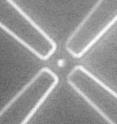Particle trap paves way for personalized medicine
Sequencing DNA base pairs – the individual molecules that make up DNA – is key for medical researchers working toward personalized medicine. Being able to isolate, study and sequence these DNA molecules would allow scientists to tailor diagnostic testing, therapies and treatments based on each patient's individual genetic makeup. But being able to isolate individual molecules like DNA base pairs, which are just two nanometers across – or about 1/50,000th the diameter of a human hair – is incredibly expensive and difficult to control. In addition, devising a way to trap DNA molecules in their natural aqueous environment further complicates things. Scientists have spent the past decade struggling to isolate and trap individual DNA molecules in an aqueous solution by trying to thread it through a tiny hole the size of DNA, called a "nanopore," which is exceedingly difficult to make and control.
Now a team led by Yale University researchers has proven that isolating individual charged particles, like DNA molecules, is indeed possible using a method called "Paul trapping," which uses oscillating electric fields to confine the particles to a space only nanometers in size. (The technique is named for Wolfgang Paul, who won the Nobel Prize for the discovery.) Until now, scientists have only been able to use Paul traps for particles in a vacuum, but the Yale team was able to confine a charged test particle – in this case, a polystyrene bead – to an accuracy of just 10 nanometers in aqueous solutions between quadruple microelectrodes that supplied the electric field.
Their device can be contained on a single chip and is simple and inexpensive to manufacture. "The idea would be that doctors could take a tiny drop of blood from patients and be able to run diagnostic tests on it right there in their office, instead of sending it away to a lab where testing can take days and is expensive," said Weihua Guan, a Yale engineering graduate student who led the project.
In addition to diagnostics, this "lab-on-a-chip" would have a wide range of applications, Guan said, such as being able to analyze how individual cells respond to different stimulation. While there are several other techniques for cell-manipulation available now, such as optical tweezers, the Yale team's approach actually works better as the size of the targets gets smaller, contrary to other approaches.
The team, whose findings appear in the May 23 Early Edition of the Proceedings of the National Academy of Sciences, used charged polystyrene beads rather than actual DNA molecules, along with a two-dimensional trap to prove that the technique worked. Next, they will work toward creating a 3-D trap using DNA molecules, which, at two nanometers, are even smaller than the test beads. They hope to have a working, 3-D trap using DNA molecules in the next year or two. The project is funded by a National Institutes of Health program that aims to sequence a patient's entire genome for less than $1,000.
"This is the future of personalized medicine," Guan said.
Source: Yale University
Other sources
- Particle trap paves way for personalized medicinefrom Science DailyMon, 23 May 2011, 20:30:24 UTC
- Development of DNA trap paves way for personalized medicinefrom PhysorgMon, 23 May 2011, 19:00:32 UTC
